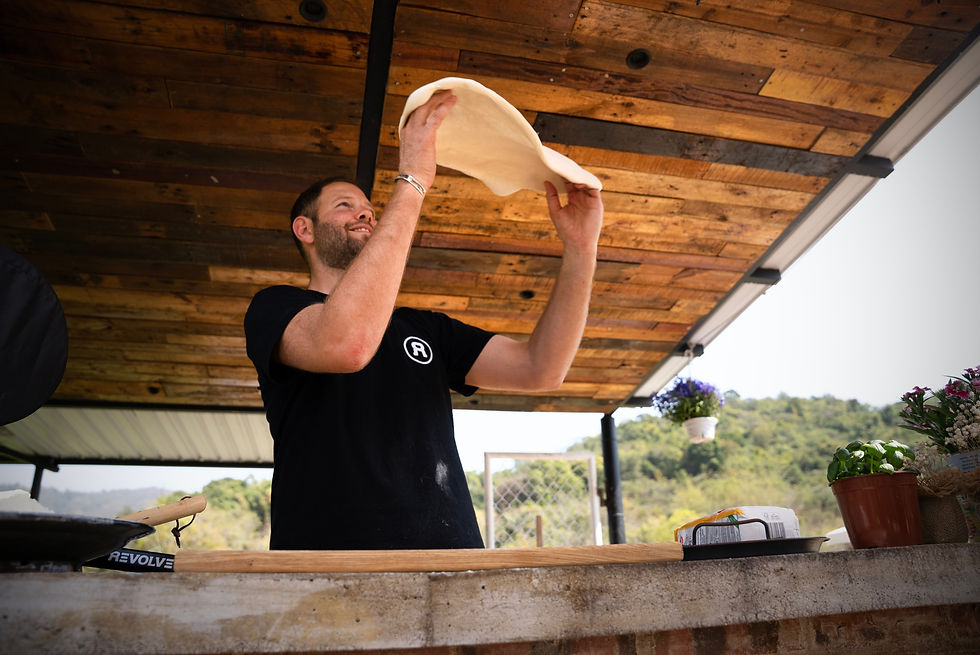On This Day In Food: National Pepperoni Pizza Day
- Robin Bacon
- Sep 20, 2023
- 3 min read
Updated: Sep 21, 2023
"Work hard, be nice, eat pizza." ~ Anonymous

Memories Of Eating Pizza
Growing up in Colebrook, Connecticut, there weren’t many options for pizza within a 10-mile radius. Eating at a restaurant required a good 10-20-mile journey to town. On most Friday nights, my Dad would call from his office letting us know he was stopping at ABC Pizza for pie and salad. That was code for pepperoni pizza Friday. ABC was our “Go To” for a good Pizza and Greek Salad. The salad dressing was off the chain! It was made with red wine vinegar, vegetable oil, and a combination of dried herbs. It was served over iceberg lettuce, black and kalamata olives, genoa salami, ham, provolone, and other meats & cheeses. Coupled with a pepperoni pizza, it was a great way to spend an pizza night, hangin' out with Dad, and harvesting leftover Fall vegetables from the garden.

In New Haven, Connecticut, I explored the flavors of authentic “Apizza” from Sally’s - the coal-fired ovens on Wooster Street. The Modern Apizza has the best anchovies and artisanal pepperoni, an old-world rustic flavor. Of course, Frank Pepe Pizzeria Napoletana to indulge in their cured meat pies - to die for!
The Many Types of Pepperoni
Our family loved imported meats; we were always willing to take a 30-mile journey to the south end of Hartford to pick up some of the best-cured meats at the time. My dad introduced us to imported meats and cheeses from Italy at a young age, and we were hooked. We make homemade sheet pan pizza as kids. We ran our Liberty Bell wood stove on high in the winter to keep us warm on those cold January nights.
After the journey, we came with a pound of Calabrese Salami (pepperoni), freshly made pizza dough by the pound, from Nona in the back. The prosciutto was paper thin, aged well, and was a treat for us to eat while the deli man sliced the provolone and mozzarella. I learned how to make pizza with fresh mozzarella, provolone, and parmesan cheese from scratch. When selecting pepperoni, flavor profiles are essential - so taste it before you buy it. Any butcher will gladly offer you a slice to taste test. Making pepperoni begins with pork and beef; the meat-to-fat ratios are usually 70/30. The casing, herbs and spices, and aging are crucial for additional layers of flavor. Significantly, the old World Cup and Char, where there is just enough collagen to help the fat flavor pool into the basin of each meat slice as it’s cooked off in the oven, makes it a flavor bomb with each bite.

Making That Pepperoni Pizza
We made sheet pan pizza, and started by proofing the dough and gathering ingredients. I ran to the storage rack and grabbed a 1-quart jar of Roma tomatoes; my dad added basil, salt, pepper, crushed red pepper, and sugar. He poured it all into a bowl, hand-crushed it, and ans set it aside until he was ready to make the pies. As the dough was proofed, he sliced up the pepperoni and pulled out the cheese, herbs, and spices. Once the dough was ready, we gently hand-rolled it and laid it into each sheet pan. He added olive oil to the dough and spooned on the homemade pizza sauce. We were ready to layer meat & cheese! Once we finished loading the pizza with toppings, we baked it in the oven for about an hour. He used to call it bar pizza, cut into squares, flavorful and hearty enough to hold to beer and Saturday afternoon football.
As we celebrate National Pepperoni Pizza Day, go back in time to recall your first experience with pizza. It could be factory pie from the freezer. Or, you loaded French bread style, with sauce and cheese. No matter your first experience is corporate pizza, homemade, or cobbled together for a quick lunch, go back in time and try to reconstruct that dish with your kids. You’ll hold that memory in your heart and each time you order pepperoni pizza - you’ll think back to that day when you created memories and experiences with food.







Comments